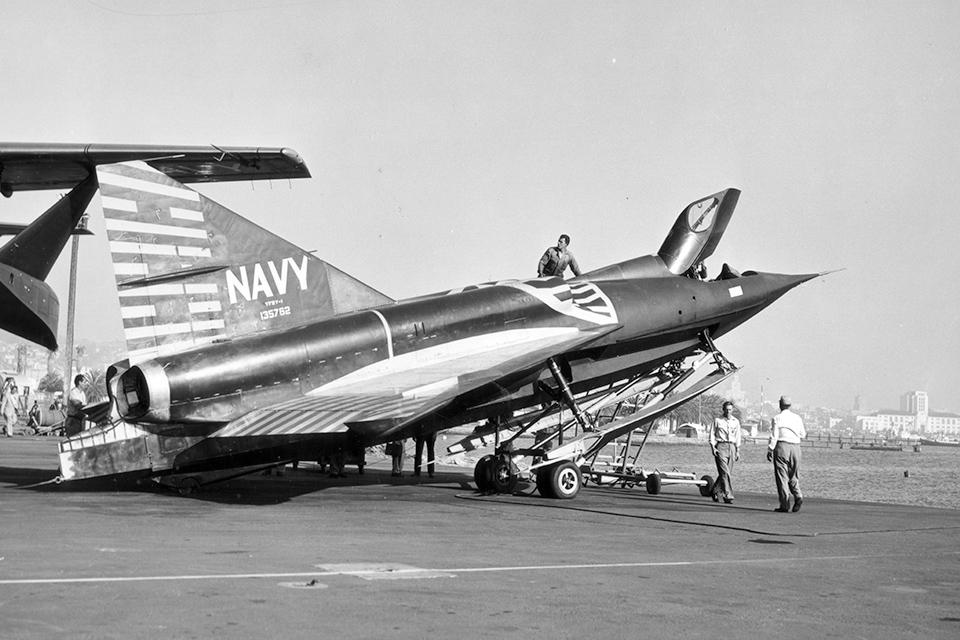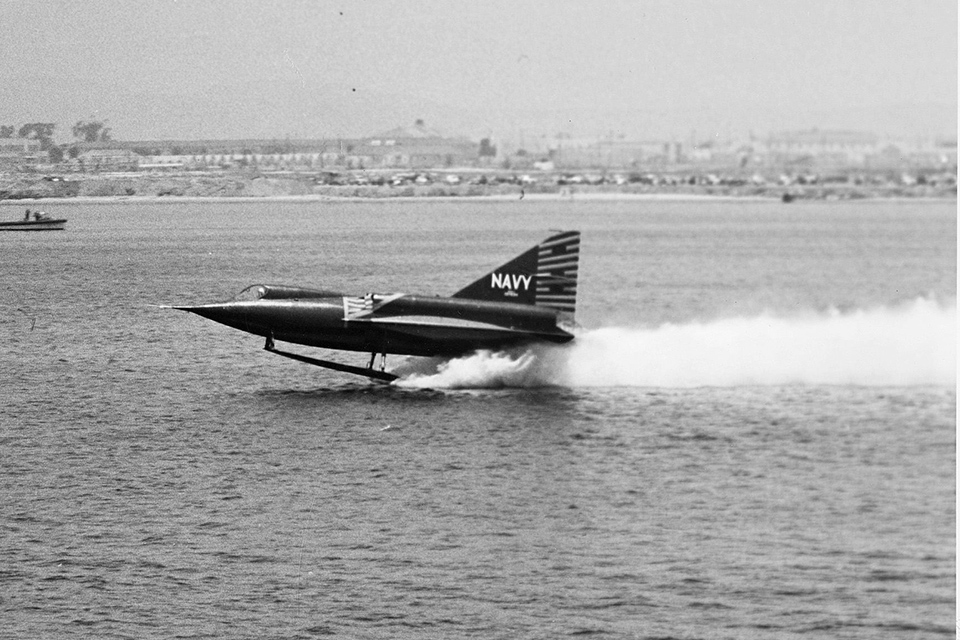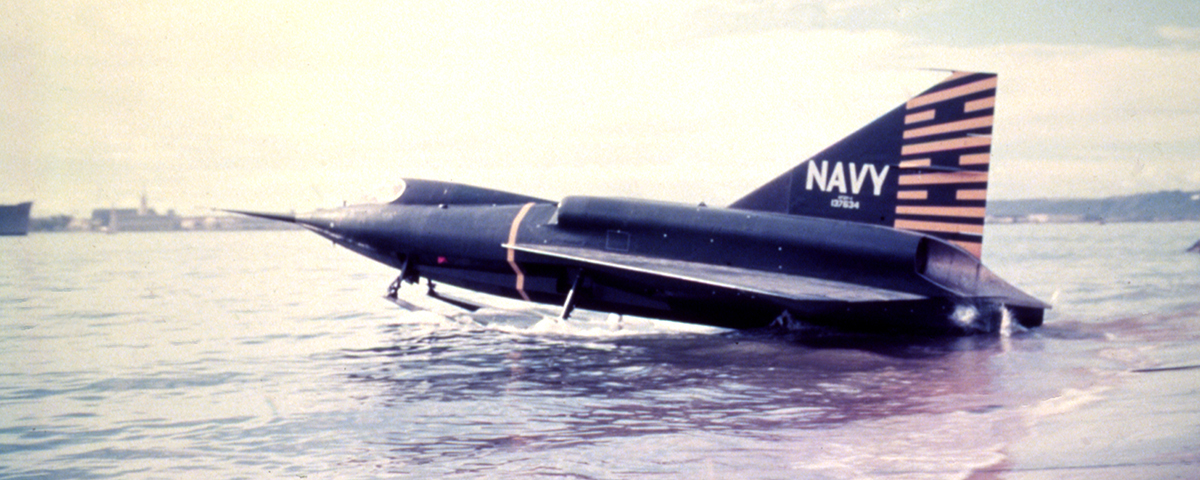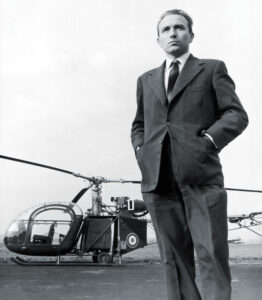The advent of jet propulsion in the 1940s ushered in a whole new era of aircraft development. In the decade and a half following World War II, a remarkable variety of high-performance planes were designed and tested, some of which bordered on the bizarre. Not the least among these was the Convair XF2Y-1 Sea Dart, a supersonic jet fighter flying boat that was designed to take off and land on water skis, the first and likely last such aircraft ever flown.
In the late 1940s, the U.S. Navy’s first generation of straight-winged jets proved amenable to existing carrier decks, but their performance lagged behind their Air Force contemporaries. Moreover, it was generally believed that WWII-vintage carriers would be inadequate to accommodate the upcoming generation of supersonic jets. The Navy’s first postwar aircraft carrier design, United States, would have displaced 83,000 tons— compared with the 27,000-ton Essex and 45,000-ton Midway classes of WWII—with a flight deck more than 1,000 feet long and nearly 200 feet wide, to accommodate aircraft of up to 100,000 pounds. In 1949, however, United States was canceled.
As a result the Navy began to explore other means of operating high-performance aircraft from existing seaborne platforms. One avenue of research led to the testing of bizarre tail-sitting VTOL fighters such as the Lockheed XFV-1 “Salmon” and Convair XFY-1 “Pogo.” A more conventional tack involved development of a waterborne fighter that wouldn’t require a shipboard flight deck at all.
The idea was not new. Both sides built and flew floatplane and flying boat fighters in World War I. During WWII, Japanese floatplane fighters operated from island bases throughout the Pacific. In 1943 the Saunders-Roe firm proposed a jet-powered, single-seat flying boat fighter. The SR.A/1 did not fly until 1947, however, by which time the British Admiralty deemed it unnecessary, and it fell victim to postwar defense budget cuts.
Although the U.S. Navy was undoubtedly aware of the SR.A/1, it had a far higher level of performance in mind, requiring a fresh approach. In November 1949, the Navy contracted Convair to tackle the problem.
Convair had been formed in 1943 from the merger of two aircraft companies, Consolidated and Vultee. Consolidated had produced flying boats for the Navy since the late 1920s, including the famous PBY Catalina patrol bomber. As a result, Convair had plenty of flying boat design experience to tap into.

In addition, Convair’s postwar work with delta wings was on the cutting edge of high-performance aircraft design. In August 1945, the Army Air Forces had contracted the company to design a supersonic interceptor. While engaged in that project, Convair’s design team came upon the delta-wing research conducted by Alexander Lippisch, who had been among the German scientists brought to the U.S. at the end of WWII through Operation Paperclip. In addition to the Messerschmitt Me-163 Komet rocket fighter, Lippisch had designed a supersonic, ramjet-powered, delta-wing interceptor for the Luftwaffe that didn’t get beyond the glider-testing stage before war’s end. Picking up where Lippisch had left off, Convair produced the XF-92A, the first American deltawing aircraft, which first flew on April 1, 1948. The experimental XF-92A eventually led to the U.S. Air Force’s supersonic F-102 and F-106 interceptors and B-58 bomber, as well as the Navy’s XF2Y-1 Sea Dart.
The Sea Dart was a single-seat fighter with a wingspan of 33 feet 8 inches and a length of 52 feet 7 inches. Its armament was meant to include four 20mm cannons and a battery of 44 2.75-inch rockets, although no weapons were ever actually installed. The fighter’s intended maximum speed of 825 mph at 36,000 feet, 54,800-foot service ceiling and initial climb rate of 17,100 feet per minute were probably never achieved either. Nevertheless, the Sea Dart was unquestionably the highest-performance seaplane ever built.
Convair intended to power the Sea Dart with a pair of Westinghouse J46 after-burning turbojets with 6,000 pounds of thrust each. The first airframe was ready before the engines were, however, so the prototype had to make do with a pair of 3,400-pound-thrust Westinghouse J34s.
Although the Sea Dart bore a family resemblance to the Air Force’s F-102, it included some unique design features. Its fuselage was built as a watertight hull, with multiple sealed bulkheads. It also had a rather large watertight fairing below and behind the tail to keep the jet exhausts clear of the water. For that same reason the jet intakes were located on top of the fuselage, above and behind the wing’s leading edge. Flaps installed on the bottom of the fuselage served as air brakes as well as water brakes and a water rudder.
While stationary or taxiing the Sea Dart rode on a V-shaped hull like a flying boat, but with the trailing edges of the wings touching the water. At 10 knots the pilot partially extended a pair of water skis from the bottom of the hull in order to increase speed for takeoff. Once the plane reached 55 knots, he extended the skis all the way, supporting the wings at the optimum angle of attack for takeoff. The takeoff and landing speed was about 132 mph. Small retractable wheels were built into the trailing edges of the water skis as well as the tail fairing, but they were meant to be used only for beaching or taxiing on land; the Sea Dart was never intended to take off or land on them.
The prototype XF2Y-1 began taxi trials on December 14, 1952, but it was not until April 9, 1953, that Convair test pilot E.D. Shannon flew it for the first time. Apart from being somewhat underpowered, the XF2Y-1 vibrated so badly on the water that it was difficult to control. Convair tried to solve the problem by fitting a single V-shaped ski to a subsequent prototype, designated YF2Y-1, but the results still weren’t satisfactory.

On August 3, Convair test pilot Charles E. Richbourg managed to push the second prototype Sea Dart through the sound barrier in a shallow dive, officially making it the world’s fastest seaplane and the only one to actually go supersonic. Nevertheless, the Sea Dart was never really considered supersonic, even when fitted with the more powerful J46 engines. The source of that problem lay in the fact that the Convair team designed the Sea Dart before it became aware of the newly discovered area rule principle. The Air Force afforded Convair the opportunity to utilize the area rule to redesign the Sea Dart’s land-based contemporary, the F-102 Delta Dagger, into the far more potent F-106 Delta Dart. But the Navy did not consider the Sea Dart worthy of such a major redesign. A total of five were built, only three of which were actually flown. Although the Navy continued to experiment with the Sea Dart throughout 1954 and 1955, Richbourg’s fatal crash in the second prototype on November 4, 1954, pretty much put an end to the program.
What really killed the Sea Dart, however, were major changes in naval aviation after the program was initiated. Thanks largely to Britain’s Royal Navy, the U.S. Navy introduced angled flight decks and automatic landing signals on its carriers. Those innovations made high-speed deck landings much safer, even on WWII-vintage carriers. More important, as a result of the effectiveness of carrier-based air support in the Korean War, in 1952 Congress decided to fund the construction of four new 78,000-ton Forrestal-class supercarriers. Their 1,000- foot flight decks and design improvements meant there was no longer any question of the feasibility of operating supersonic aircraft from carriers, rendering the Sea Dart a developmental dead end.
Perhaps the strangest aspect of the Sea Dart’s abortive career was that it received an official change of designation long after it had been relegated to history. It seems Secretary of Defense Robert McNamara couldn’t get used to the separate aircraft designations used by the Air Force and the Navy, so he unified the two systems in 1962. Thus the F2Y-1s, which had been in storage but still listed in the Navy’s inventory, became F-7s—a full seven years after flight-testing ended.
Considering that only five Sea Darts were built, one of which crashed, it is surprising that three of them still exist. Today one is preserved at the Delaware Valley Historical Aircraft Association, Naval Air Station Willow Grove, Pa. Another resides at the San Diego Air and Space Museum in California, and the third is on display at the Florida Air Museum at Lakeland.
Originally published in the January 2009 issue of Aviation History. To subscribe, click here.





